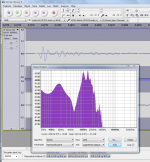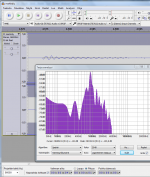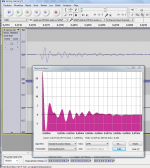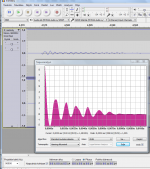Knock test continued
Different finished speaker cabinets measured wit Zoom Q3
Factory-made Tannoy Mercury FR (LDF 9mm, 3Liter BR, no braces,additional stuffing)
Factory-made Infinity Alpha20 (MDF12mm 12liter BR, no braces)
DIY ZaphL18/MarkK ERD18DXT (MDF 25mm 14liter BR, braces, moderate stuffing
Different finished speaker cabinets measured wit Zoom Q3
Factory-made Tannoy Mercury FR (LDF 9mm, 3Liter BR, no braces,additional stuffing)
Factory-made Infinity Alpha20 (MDF12mm 12liter BR, no braces)
DIY ZaphL18/MarkK ERD18DXT (MDF 25mm 14liter BR, braces, moderate stuffing
Attachments
Last edited:
Here's the connection: at resonance mass reactance and stiffness reactance balance out and there is no resistance to motion unless there is damping. Concrete has little inherent damping so there will be resonances ("rings like a bell"). ...
By your reasoning, a bell cast from concrete should perform well. 🙂
I have some concrete paving slabs, I should suspend one and hit it with a hammer while recording the sound. Have to wait for a windless day, which doesn't happen here often...
I think he means that the resonant frequency of even concrete is still going to have some sort of audible effect on box construction and no mater what the box is made of it must be taken into account in the design.
I have heard concrete pipes ringing fairly strongly and think about clay pots compared with similar sized wooden containers. The clay pot rings at a higher frequency than the wood and for longer
I have heard concrete pipes ringing fairly strongly and think about clay pots compared with similar sized wooden containers. The clay pot rings at a higher frequency than the wood and for longer
funny how you mentioned the clay pots as I was thinking about the radiating sound when you blow over the top of a bottle made out of glass as compared to plastic of similar size.
The plastic tends to sound deeper than the glass of the same size which goes along with the "lossy" concept.
Only problem with this perception is the possibility that I was blowing over the top of them at different speeds unintentionally.
If the bottles were identical I would the harmonic structure of the produced tone to be more 'spiky' showing multiple high Q overtones in the glass bottle, and more 'rounded' low Q overtones in the plastic. Individual resonances are likely to be obscured by their neighbours.
When comparing bottles, compare shapes like with like. The neck shape in particular will determine the resonant frequency of similar volume bottles.
yea, the more I think about it the less I think it was a good idea to try and get my head around the differences.
I was thinking about the plastic bottle as the lossy cabinet as it was a thinner plastic bottle and then there was the glass bottle that was a similar size.
However, there is too much room for human error for it to be any sort of indication as to what to expect from a rigid enclosure compared to a softer one.
I was thinking about the plastic bottle as the lossy cabinet as it was a thinner plastic bottle and then there was the glass bottle that was a similar size.
However, there is too much room for human error for it to be any sort of indication as to what to expect from a rigid enclosure compared to a softer one.
Plastic bottle is lossy compared to glass, that's simple - no need to debate that.
I have tested an enclosure type which simply blows away most others. Not sure how to get it made affordably however. Thick wood, thin wood, concrete, clay - they are all pathetic compared to... (more later, bed time)
A single material high Q material enclosure is bad to mediocre (whether thick or thin). Combine multiple (but different Q) high Q materials in the correct way and even a cabinet less than 1/4" thick can be VASTLY superior to a 3/4" thick MDF cabinet. 🙂
I have tested an enclosure type which simply blows away most others. Not sure how to get it made affordably however. Thick wood, thin wood, concrete, clay - they are all pathetic compared to... (more later, bed time)
A single material high Q material enclosure is bad to mediocre (whether thick or thin). Combine multiple (but different Q) high Q materials in the correct way and even a cabinet less than 1/4" thick can be VASTLY superior to a 3/4" thick MDF cabinet. 🙂
Last edited:
What a tease!I have tested an enclosure type which simply blows away most others. Not sure how to get it made affordably however. Thick wood, thin wood, concrete, clay - they are all pathetic compared to... (more later, bed time)
Plastic bottle is lossy compared to glass, that's simple - no need to debate that.
I have tested an enclosure type which simply blows away most others. Not sure how to get it made affordably however. Thick wood, thin wood, concrete, clay - they are all pathetic compared to... (more later, bed time)
A single material high Q material enclosure is bad to mediocre (whether thick or thin). Combine multiple (but different Q) high Q materials in the correct way and even a cabinet less than 1/4" thick can be VASTLY superior to a 3/4" thick MDF cabinet. 🙂
Haha, like the tease.
and it's not really a debate about the plastic bottle being lossy but more of the fact that you cant really judge based on the sound from it from so many other variables.
I was actually wondering how a polycarbonate or something of the like. It has high impact resistance so that could possibly, and a stress POSSIBLY, have some sort of benefit to flexing of a cabinet.
That said, the application for a more lossy cabinet would also benefit as with a molecular structure that is solid and void of any flaws it could flex in a manner that was consistent and more predictable.
However, I imagine that working with such a material could be difficult, especially in a DIY/hobby approach.
Just for the sake of completeness, Earl Geddes uses polyurethane panels.
even better seeing as how polyurethane has some characteristics similar to rubber it would probably mimic the bitumen effect that is claimed to be of use in the Harbeth and other BBC monitors
Harwood mentioned the high performance of reinforced plastics because of their strength and high internal damping. He discarded them because of their high price.
That was 1977.
That was 1977.
What about a rubber bucket then? (used as a sealed enclosure for a mid woofer in a 3 way for example)
Ok I will reveal - the enclosure I tested was metal spheres. Well you say, we already knew that - metal is very strong and the sphere is the strongest shape. Well metal also "rings like a bell"... so I used two concentric spheres (one aluminum one steel) glued together with contact cement. I am not certain, but I believe the key that made the enclosure so stunningly superior was that the glue never actually dried.Haha, like the tease.
I did not pursue the enclosure much further at the time because I failed to come up with a commercially viable supply of the spheres. I do wish I could stamp them in my garage 😛
I'm sorry but I believe quite the opposite - if you can't push resonances either above or below the pass-band then the goal is to not only divide them up into mutually destructive frequencies, but also to distribute them to the point where you do not have peaks extending higher (amplitude wise) into the range of audibility!That said, the application for a more lossy cabinet would also benefit as with a molecular structure that is solid and void of any flaws it could flex in a manner that was consistent and more predictable.
Being able to obtain the material(s) in sufficient quantity at an affordable price is essential of course.However, I imagine that working with such a material could be difficult, especially in a DIY/hobby approach.
I wanted to use Beryllium dust caps on our woofers with 2" voice coils, until I saw the price* (the company I was at makes their own woofers).
*Knowing full well that the cost of materials/parts can't realistically be much higher than 10% of the selling price of the finished product...
There's a problem with that - it will not sufficiently isolate the mid from the back-wave pressure of the woofer. Unless you had an additional stiff enclosure surrounding the mid's "rubber bucket".What about a rubber bucket then? (used as a sealed enclosure for a mid woofer in a 3 way for example)
Having a rubber bucket inside (and slightly seperated from) an additional external enclosure IS a good idea - depending somewhat on the viscosity of the rubber. You want one which is not "bouncy", but rather more prone to converting flexing into heat.
Last edited:
There's a problem with that - it will not sufficiently isolate the mid from the back-wave pressure of the woofer. Unless you had an additional stiff enclosure surrounding the mid's "rubber bucket".
Having a rubber bucket inside (and slightly seperated from) an additional external enclosure IS a good idea - depending somewhat on the viscosity of the rubber. You want one which is not "bouncy", but rather more prone to converting flexing into heat.
I was thinking of using the rubber enclosure on top of the enclosure of the woofer. It should be possible to find a bucket with the exact same diameter of the woofer hole, so that it can be attached (somehow...) directly to the bucket without resorting to a baffle.
The problem with using an external stiff box around the rubber one (for use inside another enclosure or as an external box) is that the driver has to be
decoupled from it, and that could be difficult to do 😕
What do you mean by "bouncy"?
I would have think any rubber bucket that is meant to be used for cement and the like would be good enough?
I was just reading about KEF LS50 and there cabinet vibrations were minimized using a damping layer between braces and box shell. Rubber might be too stiff but bitumen pads could work best. Stiff connection between box and braces makes vibration go higher and to a more easily audible area.
I think knock test is still relevant. The shorter, lower and quieter (duller) the knock-sound, the better.
I think knock test is still relevant. The shorter, lower and quieter (duller) the knock-sound, the better.
Critofu,
So your spheres were indeed lossy but also stiff enough to possibly have some benefit but also were still very strong.
That goes along with what I mean by the box needs to be tuned like an instrument. Careful attention should be paid to the different panels of a box and where/how much bracing should be used.
I dont know if I made myself clear when i was talking about the molecular structure. What I was trying to get at is that for a lossy cabinet design it would most likely be of some benefit to no use wood/mdf and something that will have a uniform structure so that the cabinet flex can be measured and not vary, atleast to an extreme degree with the various temperatures that the cabinet will encounter.
But heck, you can still only take it so far. Then you look at more of a "full loss" and just go with a Open Baffle speaker...granted this is an entirely different approach to speaker design but without a box it is almost like a full loss design since you will be getting sound from the front and rear wave unlike the goal to have the deadest box possible.
The only problem/worry I have about open baffle speakers is the fact that I don't fully understand the way that the frequencies are canceled and worry that it may not work will for Home theater applications which is a very big part of my audio addiction.
So your spheres were indeed lossy but also stiff enough to possibly have some benefit but also were still very strong.
That goes along with what I mean by the box needs to be tuned like an instrument. Careful attention should be paid to the different panels of a box and where/how much bracing should be used.
I dont know if I made myself clear when i was talking about the molecular structure. What I was trying to get at is that for a lossy cabinet design it would most likely be of some benefit to no use wood/mdf and something that will have a uniform structure so that the cabinet flex can be measured and not vary, atleast to an extreme degree with the various temperatures that the cabinet will encounter.
But heck, you can still only take it so far. Then you look at more of a "full loss" and just go with a Open Baffle speaker...granted this is an entirely different approach to speaker design but without a box it is almost like a full loss design since you will be getting sound from the front and rear wave unlike the goal to have the deadest box possible.
The only problem/worry I have about open baffle speakers is the fact that I don't fully understand the way that the frequencies are canceled and worry that it may not work will for Home theater applications which is a very big part of my audio addiction.
I was just reading about KEF LS50 and there cabinet vibrations were minimized using a damping layer between braces and box shell. Rubber might be too stiff but bitumen pads could work best. Stiff connection between box and braces makes vibration go higher and to a more easily audible area.
I was considering using duct seal. for the "mastic" in my new cabinets between a cross-brace and the cabinet.
Thoughts?
- Home
- Loudspeakers
- Multi-Way
- Interesting read I found on Lossy Cabinet designs by Harbeth





